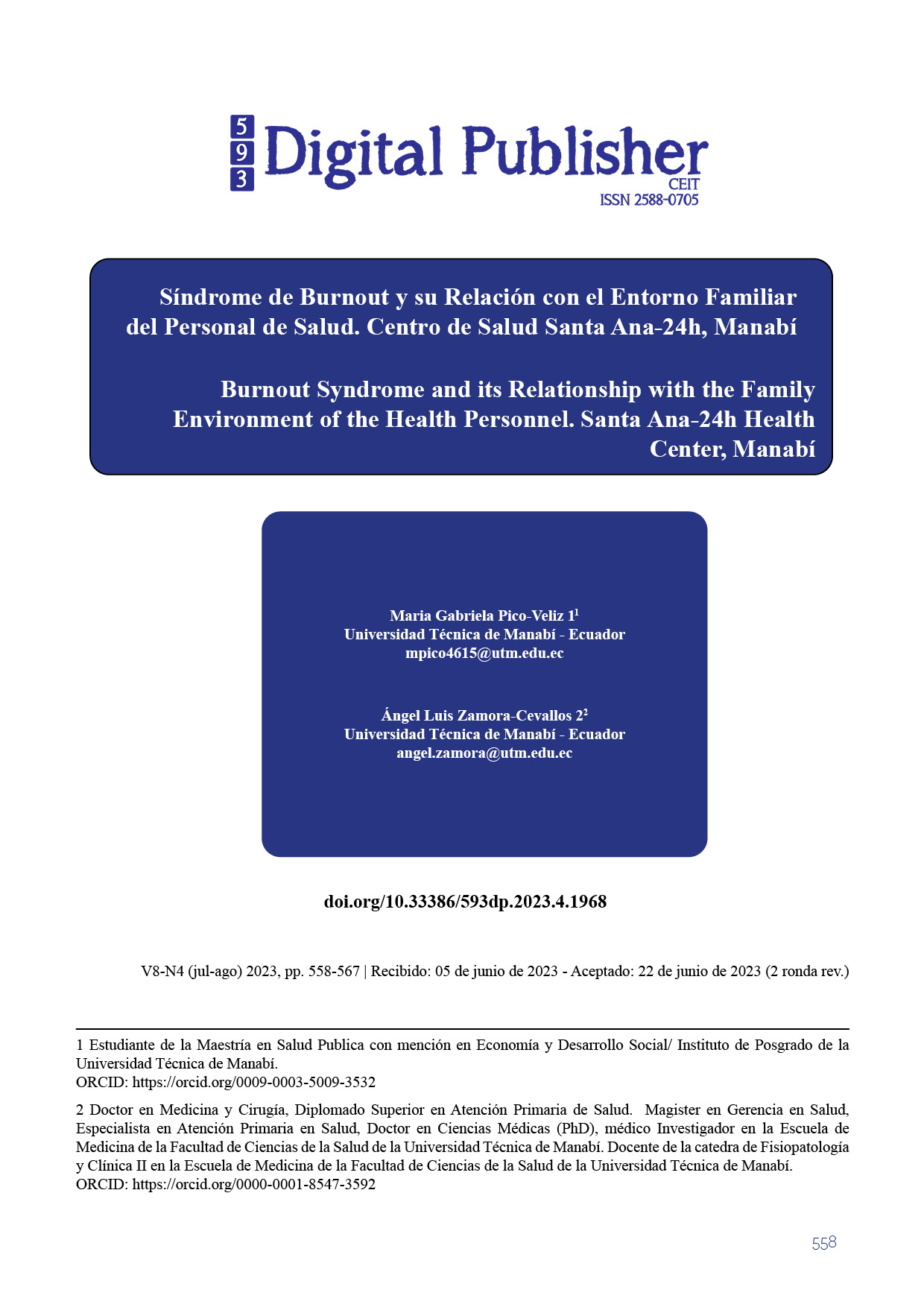Burnout Syndrome and its Relationship with the Family Environment of the Health Personnel. Santa Ana-24h Health Center, Manabí
Main Article Content
Abstract
This study analyzes the influence of Burnout syndrome on the family environment of the health personnel at the Santa Ana Center, Manabí, given the increasing prevalence of stress and its impact on the lives and health of these professionals. The goal is to deeply understand the impact of this syndrome at both individual and family levels to underpin the development of preventive and therapeutic interventions. In this socio-critical, non-experimental, and cross-sectional descriptive study, Burnout among health workers is examined using theoretical and empirical methods to analyze variables such as age, gender, and family functionality. The study population comprises the complete staff of the center, with a selected sample of 51 individuals. Instruments such as the Maslach Burnout Scale and the APGAR Family Functionality Scale were used, and the data was analyzed with Microsoft Excel and SPSS. The results show that Burnout is a pervasive problem affecting health professionals in multiple facets of their lives, including their physical and emotional well-being, job performance, and family relationships. Significant differences were found in the prevalence and severity of Burnout according to age and gender, suggesting the need for interventions adapted to different demographic groups. The importance of family functionality in managing Burnout is also highlighted. The research concludes that an effective, evidence-based intervention that considers individual, family, and work needs is required to address the problem of Burnout in the health sector.
Downloads
Article Details

This work is licensed under a Creative Commons Attribution-NonCommercial-ShareAlike 4.0 International License.
1. Derechos de autor
Las obras que se publican en 593 Digital Publisher CEIT están sujetas a los siguientes términos:
1.1. 593 Digital Publisher CEIT, conserva los derechos patrimoniales (copyright) de las obras publicadas, favorece y permite la reutilización de las mismas bajo la licencia Licencia Creative Commons 4.0 de Reconocimiento-NoComercial-CompartirIgual 4.0, por lo cual se pueden copiar, usar, difundir, transmitir y exponer públicamente, siempre que:
1.1.a. Se cite la autoría y fuente original de su publicación (revista, editorial, URL).
1.1.b. No se usen para fines comerciales u onerosos.
1.1.c. Se mencione la existencia y especificaciones de esta licencia de uso.
References
Adamopoulos, I., Lamnisos, D., Syrou, N., & Boustras, G. (2022). Public health and work safety pilot study: Inspection of job risks, burn out syndrome and job satisfaction of public health inspectors in Greece. Safety Science, 147, 105592. https://doi.org/10.1016/j.ssci.2021.105592
Arias, F. G. (2012). El proyecto de investigación “Introducción a la metodología científica” (6a Edición). Editorial Episteme, C.A. https://www.researchgate.net/publication/301894369_EL_PROYECTO_DE_INVESTIGACION_6a_EDICION
Bakker, A. B., & de Vries, J. D. (2021). Job Demands–Resources theory and self-regulation: new explanations and remedies for job burnout. Anxiety, Stress, & Coping, 34(1), 1–21. https://doi.org/10.1080/10615806.2020.1797695
Becerra Canales, B. D., Caruajulca Cercado, N. R., & Sánchez Vásquez, N. S. (2020). Factores y estrés laborales en los profesionales de enfermería, hospital tito villar cabezas, Bambamarca, Cajamarca. 2020. Universidad Autónoma de ICA.
Bernard, N. (2019). Resilience and Professional Joy: A Toolkit for Nurse Leaders. Nurse Leader, 17(1), 43–48. https://doi.org/10.1016/j.mnl.2018.09.007
Bucci, S., Roberts, N. H., Danquah, A. N., & Berry, K. (2015). Using attachment theory to inform the design and delivery of mental health services: A systematic review of the literature. Psychology and Psychotherapy: Theory, Research and Practice, 88(1), 1–20. https://doi.org/10.1111/papt.12029
Cevallos Zambrano, D. P., Moreira-Choez, J. S., Lamus de Rodríguez, T. M., & Sánchez-Urdaneta, A. B. (2023). Psychosocial effects of COVID-19 in Ecuadorian university professors. Revista de Ciencias Sociales, 29(2), 15–31. https://doi.org/10.31876/rcs.v29i2.39960
Clemente-Suárez, V. J., Martínez-González, M. B., Benitez-Agudelo, J. C., Navarro-Jiménez, E., Beltran-Velasco, A. I., Ruisoto, P., Diaz Arroyo, E., Laborde-Cárdenas, C. C., & Tornero-Aguilera, J. F. (2021). The Impact of the COVID-19 Pandemic on Mental Disorders. A Critical Review. International Journal of Environmental Research and Public Health, 18(19), 10041. https://doi.org/10.3390/ijerph181910041
Frielink, N., Schuengel, C., & Embregts, P. J. C. M. (2018). Autonomy Support, Need Satisfaction, and Motivation for Support Among Adults with Intellectual Disability: Testing a Self-Determination Theory Model. American Journal on Intellectual and Developmental Disabilities, 123(1), 33–49. https://doi.org/10.1352/1944-7558-123.1.33
Jia, Z., Wen, X., Lin, X., Lin, Y., Li, X., Li, G., & Yuan, Z. (2021). Working Hours, Job Burnout, and Subjective Well-Being of Hospital Administrators: An Empirical Study Based on China’s Tertiary Public Hospitals. International Journal of Environmental Research and Public Health, 18(9), 4539. https://doi.org/10.3390/ijerph18094539
Maslach, C., & Jackson, S. E. (1981). The measurement of experienced burnout. Journal of Organizational Behavior, 2(2), 99–113. https://doi.org/10.1002/job.4030020205
Maslach, C., Jackson, S. E., & Leiter, M. P. (1997). Maslach Burnout Inventory: Third edition. In carecrow Education. (Ed.), Evaluating stress: A book of resources (pp. 191–218).
Maslach, C., & Leiter, M. P. (2016). Understanding the Burnout experience: recent research and its implications for psychiatry. World Psychiatry, 15(2), 103–111. https://doi.org/10.1002/wps.20311
Mucci, N., Giorgi, G., Roncaioli, M., Fiz Perez, J., & Arcangeli, G. (2016). The correlation between stress and economic crisis: a systematic review. Neuropsychiatric Disease and Treatment, 983. https://doi.org/10.2147/NDT.S98525
Omidi, Z., Khanjari, S., Salehi, T., & Haghani, S. (2023). Association between Burnout and nurses’ quality of life in neonatal intensive care units: During the COVID-19 pandemic. Journal of Neonatal Nursing, 29(1), 144–148. https://doi.org/10.1016/j.jnn.2022.04.005
Rusca Putra, K., & Setyowati. (2019). Prevalence of Burnout syndrome among nurses in general hospitals in provincial East Java: Cross-sectional study. Enfermería Clínica, 29, 362–366. https://doi.org/10.1016/j.enfcli.2019.04.045
Takenaka, H., & Ban, N. (2016). The most important question in family approach: the potential of the resolve item of the family APGAR in family medicine. Asia Pacific Family Medicine, 15(1), 3. https://doi.org/10.1186/s12930-016-0028-9
Valera-Hernández, M. F., Arenas-Pérez, L., Fernandez-Capriles, I., Omaña-Paipilla, F., Palencia-Sánchez, F., & Cadena-Camargo, Y. (2022). Forgotten Heroes. Journal of Occupational & Environmental Medicine, 64(12), e839–e844. https://doi.org/10.1097/JOM.0000000000002717
West, C. P., Dyrbye, L. N., & Shanafelt, T. D. (2018). Physician burnout: contributors, consequences and solutions. Journal of Internal Medicine, 283(6), 516–529. https://doi.org/10.1111/joim.12752
Yoder, E. A. (2010). Compassion fatigue in nurses. Applied Nursing Research, 23(4), 191–197. https://doi.org/10.1016/j.apnr.2008.09.003



